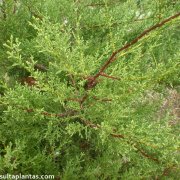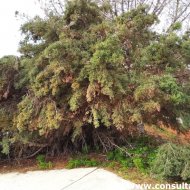Care of the tree Cupressus sargentii or Sargent's cypress |
|
The Cupressus genus, Cupressaceae family, includes 30 species of trees native to Asia, Europe and America. Some species are: Cupressus sargentii, Cupressus arizonica, Cupressus sempervirens, Cupressus funebris, Cupressus atlantica, Cupressus dupreziana, Cupressus forbesii, Cupressus macrocarpa. Common name: Sargent's cypress. This species is native to California. They are evergreen conifers with a pyramidal shape (sometimes shrubby) that reach 12 meters (39.37 feet) in height. The leaves are scale-shaped and deep green in color that contrasts with the reddish-brown stems. The flowers have no decorative interest. Sargent's cypress is used as isolated specimens, in bushy groups and even in pots. Cupressus sargentii can be grown in direct sun or semi-shade exposures. It resists the heat of the Mediterranean summer and frosts down to -20 ºC (-4 ºF). The soil can be a garden substrate with 30% coarse sand. Sargent's cypress resists drought well; water every 15-20 days in summer, every 20-25 in spring and fall and every 40-50 days in winter. Cupressus sargentii does not need fertilizers or pruning. Sargent's cypress is a plant resistant to pests and diseases. Cupressus sargentii propagates by seeds sown in spring in sandy substrate; germination does not always take place as they require the intervention of fire. |
Images of the tree Cupressus sargentii or Sargent's cypress |
Find plants
Cupressus sargentii or Sargent's cypress | Care and Growing
© 2025 FavThemes






